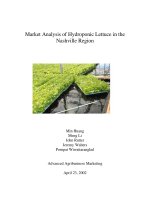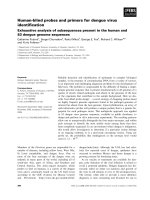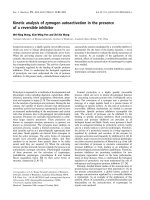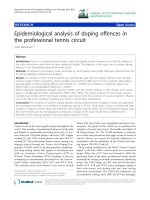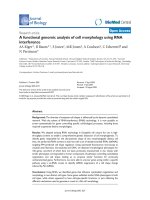FUNCTIONAL GENOMIC ANALYSIS OF GONAD DEVELOPMENT IN THE PROTANDROUS ASIAN SEABASS
Bạn đang xem bản rút gọn của tài liệu. Xem và tải ngay bản đầy đủ của tài liệu tại đây (6.93 MB, 179 trang )
1
FUNCTIONAL GENOMIC ANALYSIS OF GONAD
DEVELOPMENT IN THE PROTANDROUS
ASIAN SEABASS
JIANG JUNHUI
B.Sc (First Class Honours), National University of Singapore
A THESIS SUBMITTED FOR THE DEGREE OF
DOCTOR OF PHILOSOPHY
DEPARTMENT OF BIOLOGICAL SCIENCES &
TEMASEK LIFE SCIENCES LABORATORY
NATIONAL UNIVERSITY OF SINGAPORE
2014
I
DECLARATION
I hereby declare that this thesis is my original work and it has been written by me in
its entirety. I have duly acknowledged all the sources of information which have been
used in the thesis.
This thesis has also not been submitted for any degree in any university previously.
______________________________
Jiang Junhui
15 Sep 2014
II
Acknowledgements
I would like to thank my mentor and supervisor Prof. Laszlo Orban for
accepting me as his student and making me part of the RGG family. Every PhD
teacher-student bond is a special one and I am forever grateful and indebted to Laszlo
for the kindness and generosity that he has given to me.
Next, it would not be possible for me to embark on this long learning journey
without the support of my CEO, Ms. Tan Poh Hong, Group Director, Dr. Chew Hong
and Director, Mr. Lim Huan Sein. I would also like to thank Mrs. Renee Chou and Dr.
Ling Kai Huat for their encouragement and support.
I would also like to thank all the staff at MAC, in particular Liang Bing, Xiao
Xu, Yazid, Syed Ali, Chua and Chee. My work on the Asian seabass would not have
been possible without their help in taking care of the fishes at St John’s Island. I
would also like to thank RGG lab members Xueyan, Inna, Shubha, Keh-Weei
Natascha, Datta, Jolly, Shawn, Purush, Doreen and ex-members Rajini, Preethi, Hsiao
Yuen and Candy. I also appreciate ex-RGG PhD student, Dr. Wang Xingang, for
passing down excellent histology and FISH protocols. I would also like to
acknowledge my fellow AVA colleague, Amos Koh, and RGG PhD student, Liew
Woei Chang, for their unreserved and forthcoming sharing of fish husbandry
knowledge and laboratory techniques respectively with me. Without them, my
learning journey would have been much more difficult. I also appreciate the work of
TLL core facilities, especially the Sequencing Lab and Fish Facility, which have my
work much easier.
Lastly, I thank my loving wife for her understanding and support when I
needed to put in extra hours in the lab.
III
Table of Contents
1 Introduction 1
1.1 Hermaphroditism – a platform for the study of sex differentiation and
implications for aquaculture 1
1.2 Characteristics of the Asian seabass 4
1.2.1 Distribution, diversity and environment 4
1.2.2 Commercial importance 5
1.2.3 Male-to-female sex change 7
1.2.4 Available molecular tools for Asian seabass 8
1.3 Diversity of vertebrate sex determination 9
1.3.1 Genetic and environmental sex determination 9
1.3.2 Primary and secondary sex determination in sequential hermaphrodites 11
1.4 Conservation of vertebrate sex differentiation 12
1.4.1 Pro-male and pro-female genes of gonad differentiation 13
1.4.2 Signaling pathways involved in gonad differentiation 15
1.4.3 Steroidogenic genes – effectors of gonad differentiation 17
1.5 Sex reversal in species with GSD 19
1.5.1 Temperature and its effect on DNA methylation and cortisol levels 19
1.5.2 Steroidal treatments and changes to gene expression 20
1.6 Sex change in natural hermaphrodites 21
1.6.1 The protandrous black porgy 22
1.6.2 The protogynous groupers and wrasses 23
1.7 Zebrafish as a model for gonad differentiation studies 23
1.8 Objective and aims of this study 25
IV
2 Materials and Methods 27
2.1 Ethics Statement 27
2.2 Fish stocks 27
2.3 Captive breeding of Asian seabass 27
2.4 Histology and staging of Asian seabass gonads 28
2.5 RNA isolation and cDNA synthesis 28
2.6 Sample preparation for Asian seabass transcriptome sequencing 29
2.7 De novo assembly of the Asian seabass transcriptome 32
2.8 Design of Asian seabass expression microarray 33
2.9 Real-time qPCR using qPCR array 35
2.10 Microarray hybridization 35
2.11 Gonadotropin-releasing hormone (GnRH) induction of Asian seabass 36
2.12 Sexing of Asian seabass 36
2.13 ELISA measurement of mucus 11-KT 37
2.14 Hormone implantation in Asian seabass juveniles 37
2.15 Collection of zebrafish gonads 38
2.16 Immunohistochemistry on zebrafish gonads 39
2.17 Chemical treatments of IWR-1-endo on zebrafish 39
2.18 Heat shock experiments on zebrafish 39
2.19 Statistical analyses 40
3 Results 42
3.1 Identification of adult Asian seabass testes, transforming gonads and ovaries
at various sexual maturation stages 42
3.2 Detection of ‘juvenile testis’, ‘oocytes-in-testes’, primary females and
terminal males among captive-bred Asian seabass 43
V
3.3 Identification of Nile tilapia orthologous proteins in the Asian seabass
transcriptome 51
3.4 Gene expression analysis revealed differences in the sexual maturation stages
of testes and ovaries 51
3.4.1 Sexually dimorphic expression of genes between seabass testes and
ovaries 52
3.4.2 The expression profiles of 36 genes were sufficient to distinguish
between male and female gonads types 52
3.4.3 Female-like expression levels of amh and germ cell markers in M1 testes
55
3.4.4 Increased variation of testicular zp2 expression as a consequence of the
presence of primary oocytes in some Asian seabass testes 56
3.4.5 Sexually dimorphic expression of cyp11c1 and esr1 is independent from
the maturation status of gonads 57
3.5 Microarray analysis revealed a similarity in transcriptomic profiles between
the undifferentiated and early transforming gonads 57
3.6 Real-time qPCR verified the involvement of genes and pathways during
Asian seabass gonad transformation as shown by microarray analysis 61
3.7 No widespread difference was found between the transcriptomic profiles of
adult Asian seabass male and female whole brains 65
3.8 Two GnRH isoforms were identified in the transcriptome of Asian seabass . 65
3.9 GnRH induction resulted in sexually dimorphic increase in mucus 11-KT
production 66
3.10 Long term treatment of GnRH can promote development of testis 69
VI
3.11 Zebrafish ‘juvenile ovary-to-testis’ type gonad transformation involves the
differential expression of several Wnt signaling genes 71
3.12 Functional analysis of the role of Wnt signaling in zebrafish gonad
transformation 72
3.12.1 No detection of dGFP expression in Tg(TOP:GFP) zebrafish gonads 72
3.12.2 Chemical treatments did not consistently change sex ratio, but down-
regulated the expression of cyp19a1a 73
3.12.3 Transgenic inhibition of canonical Wnt signaling pathway promoted
testis formation in zebrafish 74
3.12.4 Heat shock-based activation of dkk1b resulted in responsive down-
regulation of cyp19a1a 78
4 Discussion 81
4.1 New insights into the reproductive life cycle of the Asian seabass 81
4.1.1 Mandatory juvenile testis stage 81
4.1.2 ‘Oocytes-in-testis’ as a possible sign of sex change 83
4.2 qPCR-based analysis of a limited set of sex-related genes is a powerful
method to uncover new molecular insights 85
4.2.1 Complexity and variability of gonad development in Asian seabass 85
4.2.2 Identification of genes with expression characteristic of specific gonad
types 87
4.3 Sex change in Asian seabass involved apoptosis and de-differentiation of
testis before gradual progression of ovarian differentiation 89
4.4 Gene expression changes during sex change reinforce the notion of
conservation of sex differentiation 90
VII
4.4.1 Down-regulation of the expression of pro-male genes during sex change
91
4.4.2 The role of cyp19a1, cyp11c1 and hsd17b1 in Asian seabass reproduction
92
4.4.3 Activation of Wnt/ß-catenin signaling pathway during sex change 95
4.4.4 Implications for other genes and signaling pathways during sex change 96
4.5 Sexual differences in brain may be mild, localized and possibly transient 99
4.6 Potential existence of long-term temporal distribution of GnRH isoforms in
Asian seabass 102
4.7 Positive effect of GnRH on mucus 11-KT level 102
4.8 Positive effect of GnRH on testis development 105
4.9 Gonad differentiation in zebrafish is regulated by the canonical Wnt signaling
pathway 107
4.10 A model of Asian seabass sexual development 110
4.11 Working hypothesis for the molecular processes involved in gonad
differentiation 111
5 Concluding remarks and future directions 116
VIII
Abstract
Sex differentiation in teleosts is highly pliable and sequential hermaphroditism
is the epitome of this characteristic. The protandrous Asian seabass (Lates calcarifer)
is such a hermaphrodite, undergoing male-to-female sex change during its sexual
reproductive cycle. While there have been detailed histological descriptions of its
sexual development, the molecular analysis of the sex change process is lacking.
Natural sex change is a useful system to understand sex differentiation, a conserved
process in vertebrates. In addition, a better understanding of sex change in Asian
seabass could form the basis for future experiments to solve sex control issues in this
aquaculture species.
In order to profile the transcriptomic changes that occurred during Asian
seabass gonad development, next generation sequencing technology was utilized to
determine the Asian seabass transcriptome. Using the information, a custom mid-
throughput qPCR array and a high-throughput micorarray was generated. At the same
time, gonad samples were collected from Asian seabass ranging from juveniles to
adults.
The histological and transcriptomic results showed that testis differentiation
occurred early at around nine months post-hatching and could be mandatory. During
gonad transformation, ‘pro-male’ genes (i.e. those with a function supporting testis
development or maintenance), such as dmrt1 and sox9, were down-regulated while
apoptosis was activated to clear the male germ cells. The early transforming gonad
thus assumed a near-undifferentiated transcriptomic state. Subsequently, ovarian
differentiation from the transforming gonad involved the activation of the ‘pro-
female’ Wnt signaling pathway. In order to understand the role of the brain in the sex
IX
change process, a microarray analysis was also carried out on the brain of adult male
and female Asian seabass, but no widespread differences could be found. This
indicated that any existing differences in expression were likely to be mild, localized
and possibly transient. Separately, Asian seabass was found to be able to respond to
gonadotropin-releasing hormone (GnRH) induction with a spike in the mucus 11-
ketotestosterone level and the magnitude of this change was dependent on the gonadal
maturation stage. Long-term treatment of GnRH could also promote the development
of spermiating testis in juvenile seabass.
To test the hypothesis on the role of Wnt signaling in ovarian differentiation,
the zebrafish model was used as it was previously shown by our laboratory that Wnt
signaling genes were differentially expressed during zebrafish’s ‘juvenile ovary-to-
testis’ transformation. Transgenic down-regulation of Wnt signaling in the
Tg(hsp70l:dkk1b-GFP)w32 zebrafish line through induced activation of dkk1b-GFP
expression resulted in an increased proportion of males with corresponding decrease
in gonadal aromatase gene (cyp19a1a) expression. These results provided the first
functional evidence that, similarly to mammals, Wnt/ß-catenin signaling is a pro-
female pathway that regulates gonad differentiation in zebrafish and possibly Asian
seabass.
The results from this study have led to a greater understanding of the sexual
development of the Asian seabass at both the developmental and molecular level. The
zebrafish has also proved itself to be a useful model system for the functional
validation of genes and pathways involved in gonad differentiation. Results from both
the Asian seabass and zebrafish have shown that despite the opposite direction of
gonad transformation, the same set of genes was involved, albeit in the appropriate
direction, reinforcing the notion that several aspects of sex differentiation is conserved
during sex reversal.
X
List of Tables
Table 1. Candidate master sex determining genes in non-mammalian vertebrates. 11
Table 2. Classification of gonads collected from adult seabass based on histological
analysis. 43
Table 3. Classification of gonads collected from juvenile Asian seabass between 4.5-9
months post hatching (mph). 46
Table 4. Frequency of spawning occasions in a group of 13 years old Asian seabass.
50
Table 5. Type of gonad samples used for the 48.48 qPCR array. 52
Table 6. Genes that were analyzed between Asian seabass testes (M3 and M4) and
ovaries (F3 and F4) and classified according to functions and pathways. 53
Table 7. Types of gonad samples used for the microarray analysis. 58
Table 8. Number of differentially expressed transcripts (DETs) between two gonad
types that are in sequential order of development 58
Table 9. Number of samples used for the real-time qPCR validation. 62
Table 10. Genes that were differentially expressed during the gonad transformation
process as verified by both microarray and real-time qPCR results. 63
Table 11. Change in mucus 11-KT levels of Asian seabass due to GnRH induction. . 68
Table 12. Differentially expressed genes between juvenile ovotestes (JOT) and
juvenile ovaries (JO). 71
Table 13. Effect of IWR1-endo treatment on family sex ratios. 74
Table 14. Differentially expressed genes between individuals with transgenic dkk1b
over-expression and controls. 79
Table 15. Summary of gene expression differences detected in brains of teleost,
mammals and birds. 101
XI
List of Figures
Figure 1. Sex determination and sex differentiation in gonochorists and sequential
hermaphrodites. 2
Figure 2. Global aquaculture production of Asian seabass. 6
Figure 3. Major aquaculture producers of Asian seabass in 2011. 6
Figure 4. Overview of the synthesis of the sex steroids in fish. 19
Figure 5. Overview of sample preparation steps for 454 FLX Titanium sequencing. . 30
Figure 6. Overview of the library preparation steps for Illumina HiSeq 2000
sequencing. 31
Figure 7. De novo assembly workflow for Asian seabass transcriptome. 33
Figure 8. Workflow for the shortlisting of sequences for microarray probe design. 34
Figure 9. Egfp expression in Tg(vasa:vasa-EGFP)zf45 transgenic zebrafish. 38
Figure 10. Stages of gonad maturation collected from adult Asian seabass based on
the classification by Guiguen et al. 1994. 44
Figure 11. Undifferentiated Asian seabass gonad with no testicular or ovarian tissues.
46
Figure 12. Physical appearance of M3 stage testes collected from a 9 mph juvenile
seabass (A) and an adult seabass (B). 47
Figure 13. The presence of primary oocytes in adult (A) and juvenile (B) testes. 48
Figure 14. Female Asian seabass could be found as early as 1.8 years of age. 49
Figure 15. Male and female Asian seabass gonads could be clearly distinguished
based on the expression of 36 genes with sex-related function. 54
Figure 16. M1 testes showed female-like expression levels of amh and male germ cell
markers. 55
Figure 17. The expression of oocyte marker zp2 showed a wide variation and an
increased level in some M3-type testes. 56
XII
Figure 18. The expressions of cyp11c1 and esr1 were high across all testes types. 57
Figure 19. The gonadal transcriptome profiles formed a V-shape clustering pattern
with undifferentiated gonads at the base and ovaries and testes at the two ends. 59
Figure 20. The undifferentiated and early transforming gonads were clustered in the
same secondary clade under the hierarchical clustering map. 60
Figure 21. PCA plot drawn using data from the real-time qPCR showed a similar
clustering pattern to that produced from the microarray experiment. 64
Figure 22. The transcriptome of Asian seabass showed the presence of at least two
isoforms of GnRH, the salmon and chicken-II. 66
Figure 23. GnRH induction resulted in increased mucus 11-KT levels except among
juveniles at two months of age. 68
Figure 24. GnRH implants, but not their combination with other compounds, resulted
in consistent increase in percentage of milting juveniles over that shown by the
control group. 70
Figure 25. GnRH implants resulted in most M3 stage testis among sacrificed
individuals. 70
Figure 26. dGFP could not be detected in the gonads of Tg(TOP:GFP) zebrafish. 73
Figure 27. GFP was highly expressed in the somatic cells of both the ovary and testis
of 44 dpf Tg(hsp70l:dkk1b-GFP)w32 zebrafish at four hours post heat shock
treatment. 75
Figure 28. Induced expression of dkk1b resulted in deformation of the caudal fin and
disappearance of the dorsal fin. 76
Figure 29. Heat-induced expression of dkk1b resulted in significant increase of
zebrafish males. 77
Figure 30. The gonadal histology of wild type (left) and Tg(dkk)/- (right) zebrafish
adults was unaffected following the heat shock. 77
XIII
Figure 31. The relative expression of cyp19a1a was significantly decreased in heat-
shocked transgenics, compared to their control siblings (also heat-treated). 79
Figure 32. The down-regulation of cyp19a1a expression (A) was responsive to the
heat activation of dkk1b (B) in 35 dpf dkk transgenic zebrafish. 80
Figure 33. Model of Asian seabass sexual development shows return of early
transforming gonad to near-undifferentiated transcriptomic state. 112
Figure 34. Simplified working hypothesis for the processes involved in gonad
differentiation. 115
XIV
List of Abbreviations
11-KT 11-Ketotestosterone
17MT 17α-Methyltestosterone
BLAST Basic Local Alignment Search Tool
BPG Brain-pituitary-gonadal axis
CSD Chromosomal sex determination
DET Differentially expressed transcripts
dpc days post coitum
dpf days post-fertilization
E2 17ß-estradiol
ESD Environmental sex determination
FDR False discovery rate
FSH Follicle-stimulating hormone
GnRH Gonadotropin-releasing hormone
GSD Genetic sex determination
JO Juvenile ovary
JOT Juvenile ovotestis
LH Luteinizing hormone
LHRHa Luteinizing-hormone releasing hormone analog
MAS Marker-assisted selection
mph months post-hatching
PCA Principal component analysis
PGC Primordial germ cell
TSD Temperature-based sex determination
XV
List of
1
Gene Symbols
18S 18S ribosomal RNA
acvr1 activin A receptor, type I
amh anti-mullerian hormone
ar androgen receptor
axin1 axin1
bactin beta-actin
bfar bifunctional apoptosis regulator
bmp1/2 bone morphogenetic protein 1/2
c6/7 complement component C6/7
catd cathepsin D
ck2a casein kinase 2 alpha
cox1 cytochrome c oxidase assembly homolog 1
ctnnb1 catenin beta 1
ctnnbip1 catenin beta interacting protein 1
ctsk cathepsin K
cyp11a1 cytochrome P450, family 11, subfamily A, polypeptide 1
cyp11c1 cytochrome P450, family 11, subfamily C, polypeptide 1
cyp17a1 cytochrome P450, family 17, subfamily A, polypeptide 1
cyp19a1 cytochrome P450 aromatase
cyp26a1 cytochrome P450, family 26, subfamily A, polypeptide 1
cyp26b1 cytochrome P450, family 26, subfamily B, polypeptide 1
Dhh Desert hedgehog
dkk1b dickkopf 1b
dkk3 dickkopf 3
dlc deltaC
dmrt1 doublesex and mab-3 related transcription factor 1
DMW doublesex and mab-3 related transcription factor 1, W-linked
dmy doublesex and mab-3 related transcription factor 1, Y-linked
dnd dead end
dvl2 dishevelled, dsh homolog 2
1
All teleost gene and protein symbols are standardized to the zebrafish nomenclature:
for gene symbol, all letters are italicized and lower case while the protein symbol is
the same as the gene symbol, but non-italic and the first letter is uppercase.
XVI
ef1a elongation factor 1-alpha
esr1/2 estrogen receptor 1 /2
foxl2 forkhead box L2
fshr follicle stimulating hormone receptor
fsta follistatin a
fzd1/8 frizzled homolog 1/8
gadph glyceraldehyde-3-phosphate dehydrogenase
gcl germ cell-less
gdf9 growth differentiation factor 9
gli1 GLI-Kruppel family member 1
gsdf1 gonadal soma derived factor 1
Hes1 hairy and enhancer of split-1
hsd11b2 11-beta-hydroxysteroid dehydrogenase type 2
hsd17b1 17-beta-hydroxysteroid dehydrogenase type 1
hsd3b 3 beta-hydroxysteroid dehydrogenase
hsp70 heat shock cognate 70-kd protein
Ihh Indian hedgehog
ikbe nuclear factor of kappa light polypeptide gene enhancer in B-cells
inhibitor, epsilon
inhbb inhibin, beta B
jag1b jagged 1b
kiss2 kisspeptin 2
kiss2r kisspeptin receptor 2
lef1 lymphocyte enhancer binding factor 1
lhr luteinizing hormone receptor
LRP5/6 low density lipoprotein receptor-related protein 5/6
LRWD1 leucine-rich repeats and WD repeat domain containing 1
nfkb2 NF-kappa-B 2
nkap NF-kappa-B-activating protein
npb neuropeptide B
nr0b1 nuclear receptor subfamily 0 group B member 1
nr5a2/4 nuclear receptor subfamily 5 group A member 2/4
odf3 outer dense fiber of sperm tails 3
peli1 pellino homolog 1
piwil1 piwi-like 1
pr progesterone receptor
XVII
psap prosaposin
psen1 presenilin 1
Ptch1 patched 1
rdh3 retinol dehydrogenase 3
rpl8 ribosomal protein L8
rspo1 R-spondin homolog
rtkn1/2 rhotekin 1/2
rttn rotatin
sdY sexually dimorphic on the Y-chromosome
sema4e semaphorin 4e
sept6 septin 6
Sf1 splicing factor 1
sh3rf1 SH3 domain containing ring finger 1
shh sonic hedgehog
smad4 MAD homolog 4
sox9 SRY-box containing gene 9
Sry sex-determining region Y
star steroidogenic acute regulatory protein
stra6 stimulated by retinoic acid gene 6 homolog
sycp1/3l synaptonemal complex protein 1/3-like
tac1/2 tachykinin 1/2
tcf4 transcription factor 4 (T-cell specific, HMG-box)
tdrd1/7 tudor domain containing 1/7
tekt1 tektin 1
tnks tankyrase
tp53 tumor protein p53
ts1 ts 1
tuba alpha tublin 1
ubq ubiquitin
unc5a unc-5 homolog A
vasa vasa homolog
vtgr vitellogenin receptor
wnt3/4a/16 wingless-type MMTV integration site family, member 3/4a/16
wt1 wilms’ tumor 1
zp1/2/3 zona pellucida glycoprotein 1/2/3
1
1 Introduction
1.1 Hermaphroditism – a platform for the study of sex differentiation and
implications for aquaculture
Sexual reproduction is a hallmark of life for the vast majority of vertebrates with
very few exceptions. It involves the production of two gametes, one of the male sex
(sperm) and the other of the female sex (ovum), each carrying half the genome. The
subsequent fusion of two such gametes creates the next generation. The significance
of this is that the processes of meiosis and fertilization result in the offspring being
genetically different from the two parents and also between siblings and this generates
the genetic diversity necessary for the selection and evolution of a species.
In most vertebrates, the two sexes are separated and this is brought about by the
processes of sex determination and sex differentiation (Figure 1). In developmental
biology, sex determination refers to the commitment of cells or tissues to the male or
female developmental fate, while sex differentiation refers to the subsequent
development of the testis and ovary from the bipotential gonad, the reproductive
organs that produce the sperm and ovum respectively (Valenzuela 2008). Gonad
differentiation is often used interchangeably with sex differentiation, although sex
differentiation can also additionally imply the development of secondary sexual
characteristics that are not part of the reproductive system. Decades of research on
vertebrate sex have also led to the current notion that the upstream signals for sex
determination are diverse while the downstream molecular regulators for sex
differentiation are conserved (Wilkins 1995, Morrish and Sinclair 2002, Graham et al.
2003, Barske and Capel 2008, Scherer 2008).
2
Figure 1. Sex determination and sex differentiation in gonochorists and
sequential hermaphrodites.
In gonochoristic species, the bipotential gonad differentiates into the testis or ovary
upon sex determination. However, in sequential hermaphrodites (e.g. male-to-female
sex changers), the bipotential gonad differentiates into the testis upon the initial or
primary sex determination signal and remains as testis until a secondary sex
determination signal triggers the sex change or differentiation into the ovary.
Among vertebrates, teleosts are the most ancient class and they are unique in
the sense that their representatives together possess almost all the known systems of
sex determination (Barske and Capel 2008), exhibit the most plastic forms of sex
differentiation (Devlin and Nagahama 2002) and present a wide diversity of sexual
reproduction strategies ranging from gonochorism to hermaphroditism (Barske and
Capel 2008). In contrast, in mammals, specifically eutherians, sex determination
involves the Y-linked Sry gene and sex differentiation is less amenable to exogenous
hormonal or steroidal manipulation (Ditewig and Yao 2005, Barske and Capel 2008).
This sex-related diversity in fish is not unexpected, given that a third genome
duplication event occurred in the teleost lineage of the ray-finned fish
(Actinopterygia) (Meyer and Schartl 1999, Taylor et al. 2003, Christoffels et al. 2004,
Jaillon et al. 2004) that provides the genetic material for divergence and speciation.
3
As a result, there are over 23,500 actinopterygians that make up about half of all
vertebrate species and over 99% belong to the teleosts (Volff 2004).
The plasticity of sex differentiation in fish has been demonstrated by a plethora
of experiments showing that sex ratios or gonad development can be easily
manipulated with exogenous sex steroids or endocrine disruptors (Devlin and
Nagahama 2002, Orban et al. 2009, Kobayashi et al. 2013). In this regard, natural sex
change in sequential hermaphrodites found in teleosts is possibly the epitome of this
plasticity, as the gonads have to retain the competency to undergo a dramatic physical
transformation from a fully functional testis to a fully functional ovary or vice-versa.
In a review by De Mitcheson and Liu (2008), functional hermaphroditism could be
found in at least 27 teleost families in seven orders with tropical marine perciforms
forming a significant group.
However, it is important to recognize that not all sequential hermaphrodites
undergo sex change that is a real de novo differentiation of the gonad, whereby the
entire gonad changes from one sex type to another sex type. Instead, in several
hermaphrodites, the gonads comprised of both testicular and ovarian tissues
simultaneously with the ovarian tissues in the regressed or non-functional form and
the testicular tissue in the active and functional form during the male phase and vice-
versa during the female phase. The protandrous gilthead seabream (Sparus aurata)
(Chaves-Pozo et al. 2005) and the serial bi-directional sex changer, Trimma
okinawae, are examples of sequential hermaphrodites with bisexual gonads
(Kobayashi et al. 2009).
The protandrous Asian seabass (Lates calcarifer), is one perciform that is
capable of sex change whereby the entire gonad changes from one sex type to another
as depicted in Figure 1 (Moore 1979, Davis 1982, Guiguen et al. 1994). In addition, it
4
is a popular aquaculture species in this region and its sexual reproduction strategy has
brought about obstacles to the genetic improvement (selective breeding) of the
species, namely in its long generation time and changing sex ratios. At the same time,
this type of natural sex change offers an excellent opportunity to understand more
about the basic molecular mechanisms involved in gonad differentiation.
Hence in this thesis, I will focus on uncovering the molecular mechanisms
regulating gonad development by using the natural sex change of Asian seabass as a
platform and concurrently, expand the existing knowledge regarding the sexual
reproduction of this commercially important species. The characteristics of the Asian
seabass and topics of sex determination, sex differentiation, sex change and the
zebrafish model will be explored in the latter sections of the Introduction.
1.2 Characteristics of the Asian seabass
1.2.1 Distribution, diversity and environment
The Asian seabass belongs to the order Perciforms and can be found naturally in
the tropical areas of the Indo-West Pacific region extending from the Indian
subcontinent to Northern Australia (Nelson 1994). The Asian seabass is also
commonly known by two other vernacular names, the barramundi and the giant perch.
Several studies have been performed on the genetic diversity of the species in
Southeast Asia and Australia (Keenan 1994, Chenoweth et al. 1998, Norfatimah et al.
2009). In particular, microsatellite-based analysis has shown that genetic differences
exist between Australian and Southeast Asian stocks with the latter more genetically
diverse than the Australian stocks (Yue et al. 2009). Given the large spread of the
Asian seabass native range, DNA barcoding of the mitochondrial cox1 gene has
further shown that Asian seabass from Myanmar and Australia may be two different
5
species (Ward et al. 2008). A recent morphology-based analysis has even concluded
that Asian seabass found at Myanmar (Lates uwisara) and Sri Lanka (Lates lakdiva)
are two separate species different from the Asian seabass found in the Indo-Pacific
region (Pethiyagoda and Gill 2012).
In the wild, Asian seabass of up to 20 kg could be found and it is a catadromous
species that migrates from inland waters of low salinity to coastal waters of high
salinity for spawning (Moore 1982). However, analysis of the barium and strontium
levels in Asian seabass scales has suggested that there may also exist marine-only
populations in Australia (Pender and Griffin 1996).
1.2.2 Commercial importance
The Asian seabass is commercially important both as a food fish and as a sport
fish. The global aquaculture production of Asian seabass has risen rapidly from near
naught in the 1970s to almost 70,000 tonnes in 2011 (Figure 2) and the majority of
this production today comes from Southeast Asia, Taiwan and Australia (Figure 3).
The rapid aquaculture expansion of this species has been primarily a result of the
successful captive spawning of Asian seabass and the development of large-scale
hatchery production techniques involving omega-3 fatty acids-enriched live feeds
(rotifers and Artemia) during the early pre-weaning stages (Dhert et al. 1990, Dhert et
al. 1992).
6
Figure 2. Global aquaculture production of Asian seabass.
Data downloaded from FAO - Fisheries and Aquaculture Information and Statistics
Service – accessed on 20/02/2014.
Figure 3. Major aquaculture producers of Asian seabass in 2011.
The global aquaculture production of Asian seabass was 69,116 tonnes in 2011 and
was contributed mainly by countries from Southeast Asia, Taiwan and Australia. Data
downloaded from FAO - Fisheries and Aquaculture Information and Statistics Service
– accessed on 20/02/2014.
This species can be cultured in both freshwater and seawater environments and
given the quality of its mild flavored white flesh, it has been promoted widely by
industrial-scale farmers to be the “next big fish” (Pierce 2006). In addition, Asian
seabass contain high levels of omega-3 fatty acids comparable to those of Chinook
salmon, mackerel and menhaden but lower than Atlantic cod (Xia et al. 2014).
However, it is also a carnivorous species requiring fishmeal and fish oil in its diet
although these can be partially replaced with plant-based substitutes (Katersky and
Carter 2009, Alhazzaa et al. 2011). The Asian seabass is also a cannibalistic species,
7
requiring frequent grading and separation of sizes to reduce cannibalism during the
early culture period (Ribeiro and Qin 2013).
1.2.3 Male-to-female sex change
The most interesting biological aspect of Asian seabass is that it is a
protandrous hermaphrodite and there have been extensive histological descriptions of
its sexual development (Moore 1979, Davis 1982, Guiguen et al. 1994, Szentes et al.
2012). Through these studies, the Asian seabass is known to generally mature as
males at 2-4 years of age before changing sex to females (Guiguen et al. 1994). In
addition, the presence of young primary females suggests that there may exist
individuals that have either skipped through or transited earlier from the male phase.
Similarly, the presence of older males suggests that there may be terminal males that
do not undergo sex change (Moore 1979, Davis 1982). In addition, no fixed size or
age at sex change could be determined (Moore 1979, Davis 1982).
The interesting sexual reproduction strategy of Asian seabass has implications
for aquaculture, a growing industry that is fast overtaking that of capture fisheries. At
the same time, natural sex change is also a good platform to understand the molecular
mechanisms of sex differentiation. As described previously, the late age at sexual
maturity, two years for males and beyond for females, means that there is a long
generation time. In addition, within the same generation of Asian seabass, a large
percentage exists as males during the early years, while a large percentage exists as
females during later years. This creates a problem in maintaining constant sex ratios
required for the production of high parental contribution in selective breeding projects
based on mass crosses.


